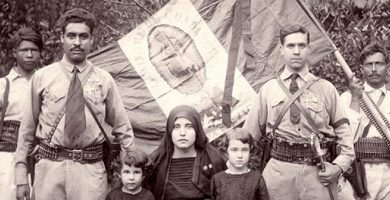What is the cultural landscape?
We explain what the cultural landscape is, its elements, characteristics and various examples. In addition, differences with the natural landscape.
-
What is the cultural landscape?
The cultural landscape is the result of the actions of the human being in a specific natural territory . It includes a space where the development of man impacts tangibly (building roads, infrastructure , etc.) and intangible (beliefs, culture , etc.), and gives added value to the region.
The cultural landscape is valuable for its natural wealth and for cultural development throughout history . However, it is not always recognized and appreciated as such, so there are many cultural landscapes that have been listed as World Heritage by UNESCO in order to preserve them.
The protection of the world’s cultural landscapes (such as forests , mountains , lakes, buildings, cities , etc.), contributes to strategies for sustainable land use, maintenance or improvement of natural resources and biodiversity conservation . Therefore, it is very important that the development of human activity accompanies the care of these landscapes.
-
Cultural landscape features

The cultural landscape harmoniously combines nature with human action. It is characterized by being a kind of legacy that reveals historical and cultural aspects of a territory , accompanied by an unrecoverable natural treasure in case of not conserving it.
The cultural landscape is important for a region from different aspects: economic (it can be used as a tourist attraction), pedagogical (studied from geography , natural sciences , history and research) and recreational (it is used as a leisure space and recreation).
In a territory considered cultural landscape, the community usually reaches a very strong sense of belonging that impacts positively on daily life (intangible value). This is generated as a result of living in an environment where nature and human development progress in synergy (tangible values).
-
Elements of the cultural landscape

Some elements of the cultural landscape are:
- The population . It refers to a group of people who inhabit a territory called cultural landscape and who tend to concentrate in an urbanized area. They are those who represent the region through their customs and tradition .
- Infrastructure . It refers to the architectural style of a region and that differentiates it from others. It can be an unsophisticated style (so as not to compete with the natural terrain in order to conserve it), such as large cities that take advantage of the geography of the place to develop.
- Industrialization . It refers to the transformation of nature by the hand of man, in order to benefit himself. This action derives in a production system that, if not properly regulated, can lead to the deterioration of the cultural landscape.
- The communication . It refers to the channels created by the human in order to connect with neighboring populations or even far away. This is achieved through roads, railways, airports, power lines and wiring, among others.
-
Examples of cultural landscape

Numerous cultural landscapes around the world are protected and preserved by UNESCO World Heritage Declarations, among them we can mention:
- The landscape of Nazca lines and Pampas geoglyphs (UNESCO 1994). Located in the arid coastal plain 400 kilometers from Lima, in Peru , the lines and geoglyphs drawn on the ground between 500 BC and 500 AD cover an area of 450 square meters. They represent one of the great enigmas of archeology due to its extension, nature and continuity with the passage of time. Some hypotheses argue that they had a ritual function related to astronomy .
- The landscape of Qhapaq Ñan (UNESCO 2014). It is located from southern Colombia through Ecuador, Peru, Bolivia, northern Chile and northwestern Argentina. It is an Andean system with extensive roads that, during the time of the Inca civilization , functioned as a link between the most important cities and favored trade. Its name means “powerful road” or “Inca road”.
- The landscape of the Camino Real de Tierra Adentro (UNESCO 2010). Located in the north of Mexico, it includes a road of about 2,600 kilometers. It is a route that connects northern Mexico with Texas, in the United States. During the 16th and 19th centuries, the road was used to transport the silver extracted from the mines of Zacatecas, Guanajanto and San Luis Potosí. In addition to favoring the mining activity, the road allowed to establish social, cultural and religious ties.
- The landscape of the Quebrada de Humahuaca (UNESCO 2003). Located in Jujuy, northern Argentina, it is an extension of the “Inca Trail” and was an important commercial route. Its mountainous landscape stands out for the variety of colors in the rocks (such as the renowned “hill of the seven colors”) and for its rich cultural heritage , which demonstrates the life of hunters and gatherers of the Omahuaca culture and some pre-Columbian vestiges and Colonial
- The Colombian coffee landscape (UNESCO 2011). Located in Colombia, it encompasses 6 coffee landscapes and 18 urban centers of the Andes Mountains. The landscape reflects the centuries-old tradition of growing coffee beans, produced in small plots that are adapted to withstand the difficult climatic conditions of the mountain area. In the surroundings, the urbanized regions present a particular architecture , influenced by the Spanish colonization.
- The landscape of the Viñales Valley (UNESCO 1999). Located in Cuba, it consists of a valley surrounded by mountains with an impressive rocky landscape and abundant vegetation. Even today, traditional practices are used for agricultural production, especially tobacco. The landscape stands out for its own architecture of the place for the construction of farms and villages. The culture of the people is characterized by being multiethnic, as a consequence of the influences of the Caribbean.
- The landscape of Rio de Janeiro (UNESCO 2011). Located between the mountain and the sea of Brazil, it consists of a large carioca city that unfolds from the mountain tops of the Tijuaca National Park to the sea. Among its great historical treasures are the Botanical Gardens created in 1808, the summit of Corcovado and its famous Christ the Redeemer, the hills surrounding Guanabara Bay and the wide landscapes of Copacabana Bay.
-
Cultural landscape and natural landscape
Unlike the cultural landscape, the natural landscape is a region where man did not intervene with his actions and that only has characteristics of the climatic, geological and natural factors.
At present, it is difficult to find accessible places that have not been intervened by man (directly or indirectly). Therefore, natural landscapes are remote, with restricted access or that are very hostile to human life.





